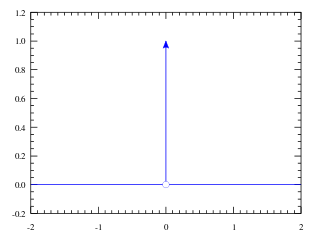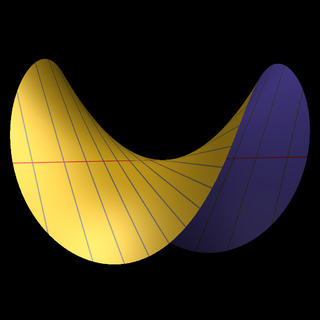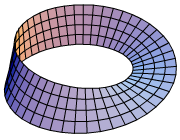
In mathematics, the Dirac delta function is a generalized function or distribution introduced by the physicist Paul Dirac. It is used to model the density of an idealized point mass or point charge as a function equal to zero everywhere except for zero and whose integral over the entire real line is equal to one. As there is no function that has these properties, the computations made by the theoretical physicists appeared to mathematicians as nonsense until the introduction of distributions by Laurent Schwartz to formalize and validate the computations. As a distribution, the Dirac delta function is a linear functional that maps every function to its value at zero. The Kronecker delta function, which is usually defined on a discrete domain and takes values 0 and 1, is a discrete analog of the Dirac delta function.
In mathematics, a Fourier series is a way to represent a function as the sum of simple sine waves. More formally, it decomposes any periodic function or periodic signal into the weighted sum of a set of simple oscillating functions, namely sines and cosines.
In mathematics, specifically in homology theory and algebraic topology, cohomology is a general term for a sequence of abelian groups associated to a topological space, often defined from a cochain complex. Cohomology can be viewed as a method of assigning richer algebraic invariants to a space than homology. Some versions of cohomology arise by dualizing the construction of homology. In other words, cochains are functions on the group of chains in homology theory.
In algebraic geometry, motives is a theory proposed by Alexander Grothendieck in the 1960's to unify the vast array of similarly behaved cohomology theories such as singular cohomology, de Rham cohomology, etale cohomology, and crystalline cohomology. Philosophically, a 'motif' is the 'cohomology essence' of a variety.
In mathematics, in the sub-field of geometric topology, the mapping class group is an important algebraic invariant of a topological space. Briefly, the mapping class group is a certain discrete group corresponding to symmetries of the space.
In mathematics, specifically in homotopy theory, a classifying spaceBG of a topological group G is the quotient of a weakly contractible space EG by a proper free action of G. It has the property that any G principal bundle over a paracompact manifold is isomorphic to a pullback of the principal bundle EG → BG. As explained later, this means that classifying spaces represent a set-valued functor on the homotopy category of topological spaces. The term classifying space can also be used for spaces that represent a set-valued functor on the category of topological spaces, such as Sierpiński space. This notion is generalized by the notion of classifying topos. However, the rest of this article discusses the more commonly used notion of classifying space up to homotopy.

In mathematics, blowing up or blowup is a type of geometric transformation which replaces a subspace of a given space with all the directions pointing out of that subspace. For example, the blowup of a point in a plane replaces the point with the projectivized tangent space at that point. The metaphor is that of zooming in on a photograph to enlarge part of the picture, rather than referring to an explosion.
In mathematics, a circle bundle is a fiber bundle where the fiber is the circle .
In mathematics, the classifying space for the unitary group U(n) is a space BU(n) together with a universal bundle EU(n) such that any hermitian bundle on a paracompact space X is the pull-back of EU(n) by a map X → BU(n) unique up to homotopy.
In mathematics, local coefficients is an idea from algebraic topology, a kind of half-way stage between homology theory or cohomology theory with coefficients in the usual sense, in a fixed abelian group A, and general sheaf cohomology which, roughly speaking, allows coefficients to vary from point to point in a topological space X. Such a concept was introduced by Norman Steenrod.
A probabilistic metric space is a generalization of metric spaces where the distance has no longer values in non-negative real numbers, but in distribution functions.
In mathematics, in particular in algebraic topology, the Hopf invariant is a homotopy invariant of certain maps between spheres.
In mathematics, Brown–Peterson cohomology is a generalized cohomology theory introduced by Edgar H. Brown and Franklin P. Peterson (1966), depending on a choice of prime p. It is described in detail by Douglas Ravenel . Its representing spectrum is denoted by BP.
In mathematics, a constructible sheaf is a sheaf of abelian groups over some topological space X, such that X is the union of a finite number of locally closed subsets on each of which the sheaf is a locally constant sheaf. It is a generalization of constructible topology in classical algebraic geometry.
In differential geometry, the integration along fibers of a k-form yields a -form where m is the dimension of the fiber, via "integration".
In algebraic geometry, given a smooth projective curve X over a finite field and a smooth affine group scheme G over it, the moduli stack of principal bundles over X, denoted by , is an algebraic stack given by: for any -algebra R,
This is a glossary of properties and concepts in algebraic topology in mathematics.

In mathematics, a configuration space is a construction closely related to state spaces or phase spaces in physics. In physics, these are used to describe the state of a whole system as a single point in a high-dimensional space. In mathematics, they are used to describe assignments of a collection of points to positions in a topological space. More specifically, configuration spaces in mathematics are particular examples of configuration spaces in physics in the particular case of several non-colliding particles.















